|
This rare Worden Combination box
and lure represents a transition from the F.G. Worden lures to the
mainstream yellow boxes made famous by the South Bend Bait Company.
Beneath the Worden Combination label on this box is a similar white
label that says "South Bend Wooden Minnow." This is the
only example of this early and rare box I've ever seen, and it likely
dates to around 1910-1912.
|
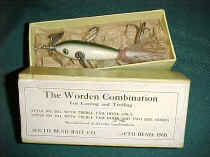 |
|
The Edward Tryon Co. of
Philadelphia manufactured this extremely rare picture box for the South
Bend Woodpecker lure. This piece is circa 1913-16. Note the box graphics
are identical to the very early South bend flyer introducing the
"night fishing" baits, and some of the verbage in the flyer is
printed on the boxtop. This is the only example of this beautiful box
I've ever seen or heard of.
|
 |
|
The South Bend
Combination Minnow combined the bucktail hackle with the underwater
minnow. The early South Bend Minnow box was sold in the early to late
teens. The spotted finish on this bait is called the "hex"
pattern, designed to imitate Heddon's popular No. 00 series minnows.
This specimen came from a nice gentleman in Paw Paw, Michigan.
|
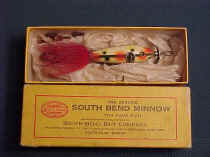 |
|
This is another early
South Bend Minnow that has milky white glass eyes and short gill marks.
This early minnow from around 1913 also has shallow cup hardware. The
color is Brown Sienna. The flyer inside offers suggestions for fishing
at night, which must have been rather popular back in those days.
|
 |
|
This is a South Bend Babe Oreno
box you won't see very often. Note that the company offering the early
lure is Shakespeare of Kalamazoo, Michigan. It seems Shakespeare sold
South Bend lures sometime in the 1916-17 era. The no-eye Babe Oreno
found in this box is the earliest version that has no washer at the tail
hook hanger or the line tie.
|
 |
The
Bass Oreno was South Bend's most famous bait. It was first called the
South Bend Wobbler. This display includes 52
different Bass Oreno lures. The oldest, with no eyes, date to the 1920s,
followed by glass eye versions from the 30s. Bass Orenos in the 40s and beyond had painted tack eyes. These lures came in
many interesting colors, making them challenging to
collect. Click on this photo to enlarge, and see if you can
identify the unusual finishes. I need a South Bend Wobbler box to add to
this display.
|
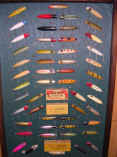 |
|
The Vacuum Bait was
acquired by South Bend from it's inventor, Professor Howe of Manchester,
Indiana, whose 1909 patent date appears on this hard-to-find square box.
Vacuum baits are wonderful lures, but they're difficult to find in
decent condition. They had vanished by the late 1920's. South Bend made
some of them with glass eyes, such as the Vacuum Bait shown here. Most
of the Vacuum Bait examples you will see have no eyes at all.
|
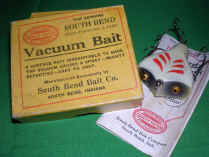 |
This
is the rare "Baby Vacuum Bait" Model No. 21 that is mint in
its original box with a wonderful color Vacuum Bait paper flyer. This
later version made by South Bend Bait Company has tack eyes and
painted-cup hardware. These are wonderful classic lures but are a terror
to find in mint condition. This one came from a visitor to this website.
|
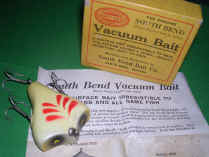 |
|
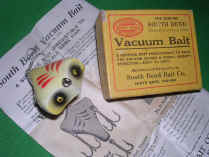 
|
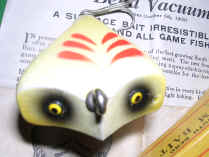 |
The
Trout Oreno emerged around 1918 and was the flyrod version of the Bass
Oreno. This set of new-in-box lures was acquired from a visitor to this
website, and includes some exceptional and rare colors, such as the blue
head/white and the luminous lures. These tiny boxes are very hard
to find, and most of them are marked on the endflap as to the color of
the lure that goes inside. They gleam like tiny jewels!
|
 |
|
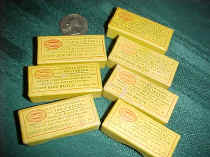
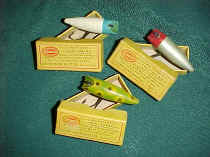
|
 |
|
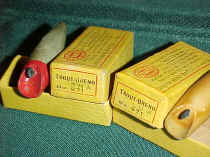 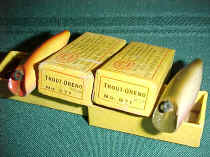
|
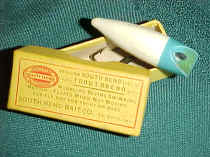 |
|
The baby Bass Oreno,
called the Babe Oreno, was made in special "Nite-Luming"
finishes, as were many of the company's baits. South Bend also made a
special Nite Luming Babe Oreno box, shown here. You won't find many.
|
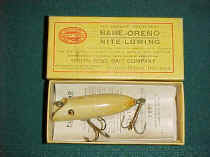 |
|
The early no-eyed Babe
Orenos came with their own special yellow box. These boxes can be found
with or without the 1916 patent date. Red and white is the most common
color for Bass Orenos and for Babe Orenos as well. The earliest babe
Orenos had no washer on the screw eye line tie in front.
|
 |
|
Sometime in the late 1920s, South Bend briefly offered the famous Bass Oreno in this colorful
box, known among collectors as the "red sky box." They tend to
fade, and most often contain a red and white glass eyed lure. This box
has a nice pike scale finish lure with the name stenciled across the
back. My friend Larry in Missouri has a great collection of these
boxes with matching Bass Orenos of all colors.
|
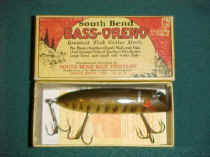 |
|
The Surf Oreno,
introduced around 1916, embodies all the traits of a classic early lure:
fat body, glass eyes and propellers. I color collected these baits early
on in the hobby and have never regretted it. This is the first Surf
Oreno box, which is unusual in that it has an applied paper label. I've
often wondered what lies beneath it, on the original box.
|
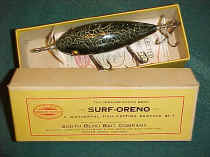 |
|
This Surf Oreno, in red
scale finish, is another early South Bend. The "intro box" was
used from the teens on into the early to mid-1920s. The Game Fish Lures
brochure inside also mentions the Bass Oreno, several flyrod baits and
other South Bend lures of that period.
|
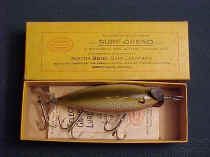 |